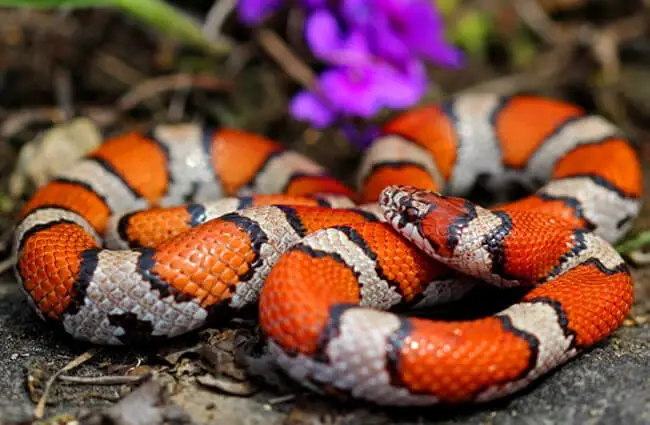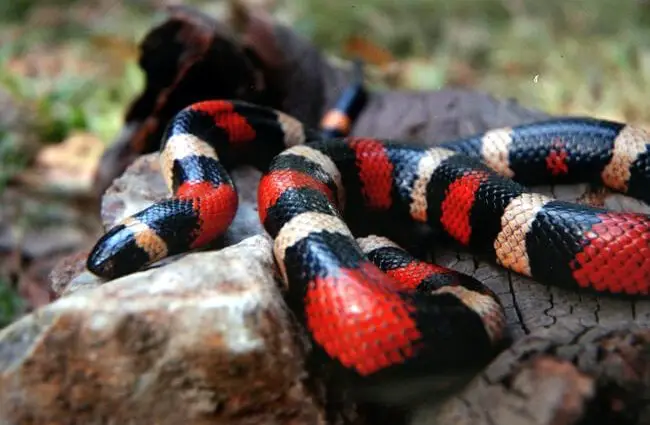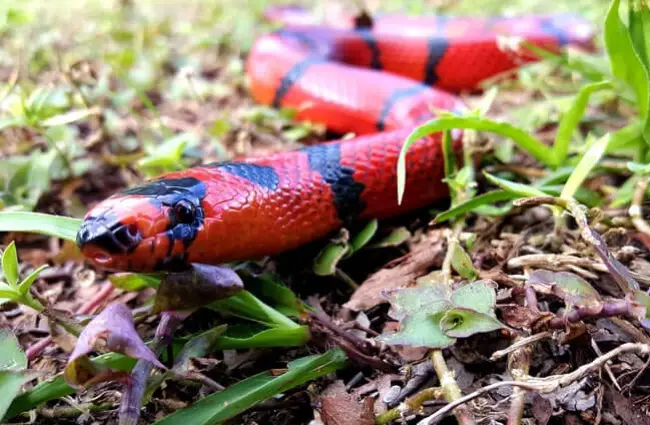The natural world is full of incredible illusions, and few are as captivating as the Milk Snake. Often mistaken for its venomous cousins, this non-venomous marvel is a master of disguise, a living testament to the power of mimicry in the animal kingdom. Far from being a mere imitation, the Milk Snake is a fascinating creature with a rich history, diverse habits, and an important role in its various ecosystems. Let us delve into the vibrant world of these remarkable reptiles.
Unmasking the Milk Snake: A Master of Mimicry
Milk Snakes, belonging to the genus Lampropeltis, which translates to “shiny shield” in Greek, are renowned for their striking patterns and colors. They are perhaps best known for their incredible resemblance to the highly venomous Coral Snake, a classic example of Batesian mimicry. This clever evolutionary strategy allows the harmless Milk Snake to deter potential predators by appearing dangerous.
These slender, medium-sized snakes typically range from 20 to 60 inches (50 to 150 cm) in length, though some individuals can grow larger. Their most distinctive feature is their banded pattern, usually consisting of alternating rings of red, black, and yellow or white. The specific arrangement and vibrancy of these bands vary significantly among the numerous subspecies, leading to a dazzling array of appearances across their vast range.

The Famous Rhyme: Distinguishing Friend from Foe
For those venturing into areas where both Milk Snakes and Coral Snakes reside, a simple rhyme often serves as a crucial guide:
“Red on yellow, kill a fellow;
Red on black, venom lack.”
This adage refers to the color sequence of the bands. In most North American Coral Snakes, the red bands touch yellow bands. In contrast, Milk Snakes typically have red bands touching black bands. However, it is important to remember that this rhyme is primarily applicable to North American species and can have regional exceptions. When in doubt, it is always best to observe from a distance and avoid handling any snake.
A World Traveler: Milk Snake Habitats and Distribution
The Milk Snake boasts one of the widest distributions of any snake species in the Americas, stretching from southeastern Canada, across the United States, and deep into Central and South America, reaching as far south as Ecuador and Venezuela. This extensive range contributes to the remarkable diversity seen within the species, with over 20 recognized subspecies, each adapted to its local environment.

Their adaptability allows them to thrive in a wide variety of habitats, making them truly versatile survivors. Common environments include:
- Forests: Deciduous and coniferous woodlands provide ample cover and prey.
- Grasslands and Prairies: Open areas with scattered rocks and brush offer basking spots and hunting grounds.
- Agricultural Areas: Farms, barns, and outbuildings are often frequented, leading to the old wives’ tale that they “milk” cows, hence their common name. This myth is, of course, entirely false, as snakes do not consume milk. They are drawn to these areas by the abundance of rodents.
- Rocky Outcrops: Crevices and rock piles provide shelter from predators and extreme temperatures.
- Swamps and Marshes: Some subspecies are comfortable in more humid, wetland environments.
- Suburban and Urban Edges: They can occasionally be found in gardens or parks, especially those bordering natural areas.
Milk Snakes are primarily terrestrial, but they are also adept climbers and can be found under logs, rocks, leaf litter, or burrowing in loose soil. They are largely nocturnal or crepuscular, meaning they are most active during twilight hours, especially in warmer climates. In cooler regions, they may be more active during the day to bask in the sun.
The Milk Snake’s Menu: A Predator’s Diet
As constrictors, Milk Snakes are efficient predators, subduing their prey by coiling around it and squeezing until respiration ceases. Their diet is varied and opportunistic, shifting based on their size, age, and local prey availability. This broad diet highlights their ecological importance in controlling pest populations.
Typical prey items include:
- Rodents: Mice, voles, and shrews are a staple, particularly for adult snakes. This is why they are often found near human dwellings and barns, where rodents are plentiful.
- Other Snakes: Milk Snakes are ophiophagous, meaning they will readily consume other snakes, including venomous species like copperheads and rattlesnakes, as well as non-venomous species. This makes them a significant predator in their ecosystem.
- Lizards: Various species of lizards, especially smaller ones, are common prey.
- Birds and Bird Eggs: They are known to raid nests, consuming both eggs and nestlings.
- Amphibians: Frogs and salamanders may also be part of their diet.
- Insects: Juveniles may start with larger insects before moving on to larger vertebrate prey.
Their ability to consume a wide range of prey contributes to their success across diverse habitats.
Life Cycle and Reproduction: The Next Generation of Mimics
Milk Snakes typically emerge from brumation, a state of inactivity similar to hibernation, in the spring as temperatures rise. This is when mating season begins, usually from April to June, depending on the geographic location.

The reproductive process involves:
- Courtship: Males locate females using pheromones. Courtship involves the male rubbing his chin along the female’s back.
- Copulation: The male aligns his body with the female’s, and copulation can last for several minutes to hours.
- Egg Laying: After a gestation period of approximately 30 to 45 days, the female lays a clutch of 2 to 17 elongated, leathery eggs. She seeks out warm, moist, and secluded locations for egg deposition, such as under logs, rocks, leaf litter, or in rotting stumps.
- Incubation: The eggs incubate for about 6 to 9 weeks, depending on temperature and humidity. The female does not typically guard the eggs after laying them.
- Hatching: Hatchlings emerge measuring around 5 to 10 inches (13 to 25 cm) long. They are miniature versions of the adults, complete with their distinctive banded patterns, and are immediately independent.
- Maturity: Milk Snakes reach sexual maturity at around 2 to 4 years of age. Their lifespan in the wild can be up to 10 years, and significantly longer in captivity, sometimes exceeding 20 years.
Evolutionary Journey: A Story of Adaptation
The widespread distribution and numerous subspecies of Milk Snakes are a testament to their long evolutionary history and remarkable adaptability. While the precise evolutionary lineage is complex and still being refined by genetic studies, it is understood that Lampropeltis triangulum, the Milk Snake species, has undergone significant adaptive radiation across the Americas. This process involved populations adapting to distinct environmental pressures in different regions, leading to the development of unique color patterns, sizes, and behaviors that characterize the various subspecies.
The evolution of Batesian mimicry in Milk Snakes is a particularly fascinating aspect. It is believed that this mimicry evolved gradually, with natural selection favoring individuals whose patterns increasingly resembled those of local venomous Coral Snakes. This provided a survival advantage against predators that had learned to avoid the dangerous Coral Snakes. The effectiveness of this mimicry varies geographically, reflecting the presence and abundance of the model species.
Ecosystem Contributions and Interactions
Milk Snakes play a vital role in their ecosystems, acting as both predator and prey, contributing to the delicate balance of nature.
- Pest Control: Their primary contribution is as effective predators of rodents. By consuming mice and other small mammals, they help control populations that can be detrimental to agriculture and carry diseases.
- Predator of Other Snakes: Their ophiophagous nature means they help regulate populations of other snake species, including venomous ones, which can be beneficial to human safety in some areas.
- Prey Item: Despite their mimicry, Milk Snakes are not immune to predation. They serve as a food source for larger predators such as birds of prey (hawks, owls), coyotes, foxes, raccoons, and even larger snakes.
- Seed Dispersal (Indirect): While not direct dispersers, by consuming rodents that might otherwise consume seeds, they indirectly contribute to plant propagation.
Milk Snakes and Humans: Dispelling Myths and Fostering Coexistence
The interaction between Milk Snakes and humans is often characterized by misunderstanding. The old myth about them milking cows is a prime example of how human observation, without full understanding, can lead to fanciful tales. In reality, Milk Snakes are drawn to barns for the warmth and, more importantly, the abundant supply of rodents.

Milk Snakes are generally docile and non-aggressive. When threatened, they may vibrate their tail (mimicking a rattlesnake), strike defensively, or release a musky odor. However, their bite is harmless to humans, typically resulting in nothing more than minor scratches. Their greatest threat comes from mistaken identity, often being killed due to their resemblance to venomous snakes.
In human culture, Milk Snakes are often featured in educational programs to teach about mimicry and snake identification. They are also popular in the pet trade due to their manageable size, striking appearance, and generally calm temperament, making them suitable for responsible reptile enthusiasts. Their beauty and intriguing biology make them excellent ambassadors for snake conservation.
Finding a Milk Snake in the Wild: Tips for Enthusiasts
For the dedicated animal lover or aspiring zoologist hoping to observe a Milk Snake in its natural habitat, patience and knowledge are key. Remember, these snakes are masters of camouflage and often secretive.
- Know Your Local Subspecies: Research the specific Milk Snake subspecies found in your region, as their preferred microhabitats and activity patterns can vary.
- Target Habitats: Focus on areas with good cover and potential prey. Look under rocks, logs, leaf litter, discarded boards, and other debris. Check around old barns, sheds, and stone walls.
- Timing is Everything: Milk Snakes are often crepuscular or nocturnal, especially in warmer months. Early morning or late evening can be productive. In cooler weather, they might bask during the day.
- Be Gentle and Observant: When lifting cover objects, do so slowly and carefully, always replacing them exactly as you found them to minimize disturbance. Look for subtle movements or patterns.
- Safety First: Always be aware of your surroundings. Wear appropriate footwear and clothing. Never reach into blind spots. Remember the rhyme for distinguishing Milk Snakes from Coral Snakes, but prioritize caution.
- Respect Wildlife: Observe from a distance. Do not attempt to handle a wild snake unless you are a trained professional and it is absolutely necessary.
Encountering a Milk Snake: What to Do
If you are a hiker or simply enjoying the outdoors and come across a Milk Snake, the best course of action is simple: admire it from a safe distance and leave it alone.
- Do Not Approach: Give the snake space. It is a wild animal and may feel threatened if approached too closely.
- Do Not Touch or Handle: Even though Milk Snakes are non-venomous, any wild animal can bite if provoked. Handling also causes stress to the snake.
- Observe: Take a moment to appreciate its beauty and unique patterns. If you are unsure of its identity, assume it could be venomous and maintain a greater distance.
- Allow it to Pass: Most snakes will move away on their own if given the opportunity. Do not try to herd or direct it.
- If it is in a Dangerous Location: If the snake is in a place where it poses a risk to itself or others (e.g., a busy road), contact local animal control or a professional wildlife rescuer. Do not attempt to move it yourself.
Remember, Milk Snakes are beneficial creatures, and their presence indicates a healthy ecosystem.
Caring for Milk Snakes in Captivity: A Zookeeper’s Guide
For zookeepers and experienced private keepers, Milk Snakes can be rewarding captives, but their specific needs must be met to ensure their health and well-being.
Enclosure Design
- Size: A secure enclosure, typically a 20-gallon long tank for juveniles and a 40-gallon breeder or larger for adults, is suitable. The enclosure should be escape-proof with a locking lid.
- Substrate: A substrate that allows for burrowing and holds some humidity is ideal, such as aspen shavings, cypress mulch, or a coco fiber/soil mix. Spot clean daily and replace entirely every 4-6 weeks.
- Hides: Provide at least two hides, one on the warm side and one on the cool side, to allow the snake to thermoregulate and feel secure. Half-logs, rock caves, or plastic containers work well.
- Climbing Opportunities: While primarily terrestrial, Milk Snakes appreciate branches or sturdy decor for climbing.
- Water Bowl: A heavy, shallow water bowl should be provided, large enough for the snake to soak in if desired, but not so deep as to pose a drowning risk for juveniles. Clean and refill daily.
Temperature and Humidity
- Temperature Gradient: Maintain a warm side ambient temperature of 80-85°F (27-29°C) and a cool side ambient temperature of 70-75°F (21-24°C).
- Basking Spot: Provide a basking spot of 85-90°F (29-32°C) using an under-tank heater with a thermostat or an overhead heat lamp. Always use a thermostat to prevent overheating.
- Nighttime Temperature: Temperatures can drop to 65-70°F (18-21°C) at night.
- Humidity: Aim for moderate humidity, around 40-60%. This can be achieved with a suitable substrate and a large water bowl. Misting occasionally, especially during shedding, can be beneficial, but avoid overly damp conditions which can lead to respiratory issues.
Diet and Feeding
- Prey: Feed appropriately sized defrosted rodents (mice or small rats). The prey item should be no wider than the widest part of the snake’s body.
- Frequency: Juveniles can be fed once a week. Adults typically eat every 7-14 days. Adjust frequency based on the snake’s body condition and activity level.
- Avoid: Never feed live prey unless absolutely necessary, as live rodents can injure the snake. Avoid handling the snake immediately after feeding to prevent regurgitation.
Enrichment and Handling
- Enrichment: Regularly rearrange decor, offer new climbing structures, or provide scent enrichment (e.g., a clean, empty toilet paper roll) to stimulate natural behaviors.
- Handling: Milk Snakes generally tolerate handling well once accustomed. Handle gently and support their body. Avoid sudden movements. Limit handling sessions to 15-20 minutes to prevent stress. Always wash hands before and after handling.
Health Monitoring
A Huge List of Interesting Milk Snake Facts

- The name “Milk Snake” comes from the old wives’ tale that these snakes would sneak into barns and drink milk directly from cows. This is entirely false, as snakes do not consume milk. They were simply found in barns because of the abundance of rodents, their actual food source.
- Milk Snakes are part of the King Snake genus (Lampropeltis), known for their ability to eat other snakes, including venomous ones. They are immune to the venom of many local pit vipers.
- Their mimicry of the venomous Coral Snake is a classic example of Batesian mimicry, where a harmless species evolves to imitate a harmful one to deter predators.
- There are over 20 recognized subspecies of Milk Snakes, each with unique color patterns and geographic distributions. Some of the most well-known include the Eastern Milk Snake, Scarlet Kingsnake (sometimes considered a subspecies), Pueblan Milk Snake, and Honduran Milk Snake.
- Milk Snakes are constrictors, meaning they kill their prey by coiling around it and squeezing until it suffocates.
- They are largely nocturnal or crepuscular, especially in warmer climates, preferring to hunt during cooler parts of the day or night.
- When threatened, a Milk Snake may vibrate its tail rapidly, mimicking a rattlesnake, even though it has no rattle.
- They are oviparous, meaning they lay eggs, typically a clutch of 2 to 17 eggs in early summer.
- Milk Snakes are relatively long-lived, often living 10 years in the wild and over 20 years in captivity with proper care.
- Their wide range spans from southeastern Canada, throughout the United States, and deep into Central and South America.
- Despite their striking appearance, Milk Snakes are non-venomous and generally docile, making them popular pets for responsible reptile keepers.
- They are excellent burrowers and climbers, utilizing a variety of habitats from forests to grasslands and agricultural areas.
- The color patterns can vary dramatically, with some subspecies having very bright reds, yellows, and blacks, while others are more subdued.
- Milk Snakes play an important ecological role by controlling rodent populations, which can be agricultural pests and disease carriers.
Conclusion: A Jewel of the Reptile World
The Milk Snake is much more than just a pretty face or a clever mimic. It is a resilient, adaptable, and ecologically significant creature that embodies the wonders of natural selection. From its intricate patterns that fool predators to its vital role in controlling rodent populations, this non-venomous snake deserves our respect and protection. By understanding its biology, habitat, and behavior, we can better appreciate its place in the natural world and ensure its continued survival for generations to come. So, the next time you hear a tale of a snake in a barn, remember the true story of the Milk Snake, a fascinating predator, not a dairy thief, and a true jewel of the reptile world.

![Red Angus Closeup of a beautiful Red Angus cowPhoto by: U.S. Department of Agriculture [pubic domain]https://creativecommons.org/licenses/by/2.0/](https://animals.net/wp-content/uploads/2020/03/Red-Angus-4-238x178.jpg)




![Red Angus Closeup of a beautiful Red Angus cowPhoto by: U.S. Department of Agriculture [pubic domain]https://creativecommons.org/licenses/by/2.0/](https://animals.net/wp-content/uploads/2020/03/Red-Angus-4-100x75.jpg)

